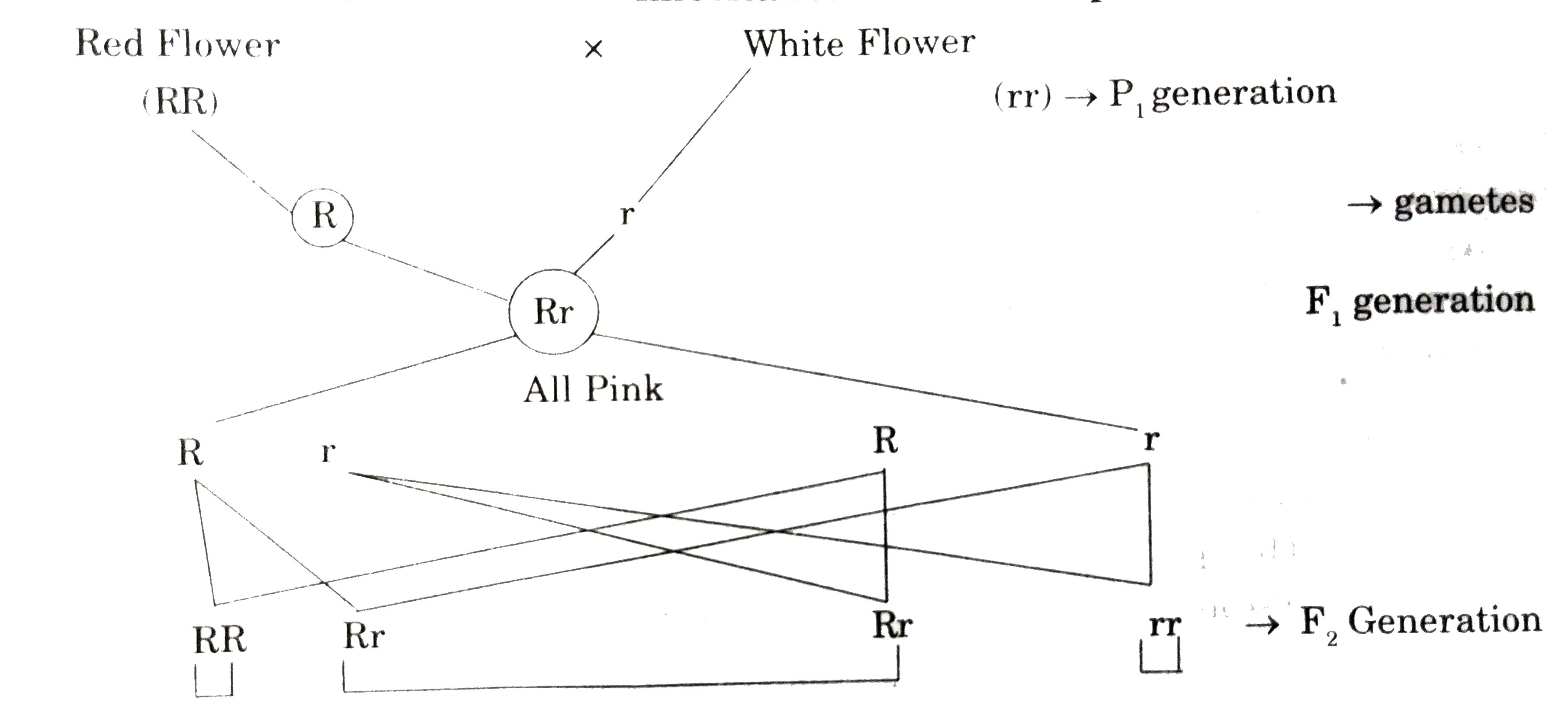In a cross between a true breeding red flowered and true breeding white flowered snapdragon plant,the F1 plants
Produced pink flowers.Name and explain the type of inheritance.
Step-by-Step Solution:
1. Identify the Parent Plants:
- We have two true breeding snapdragon plants: one with red flowers (dominant trait) and one with white flowers (recessive trait).
2. Determine the Genotypes of the Parent Plants:
- The true breeding red flowered plant has the genotype RR (homozygous dominant).
- The true breeding white flowered plant has the genotype rr (homozygous recessive).
3. Perform the Cross:
- When we cross these two plants (RR x rr), we can use a Punnett square to determine the genotypes of the offspring.
4. Analyze the F1 Generation:
- The F1 generation will all have the genotype Rr (heterozygous).
- However, instead of showing the dominant red color, the flowers of the F1 generation are pink.
5. Identify the Type of Inheritance:
- The observation that the F1 plants have pink flowers instead of red indicates that the red trait does not completely dominate over the white trait.
- This phenomenon is known as incomplete dominance. In incomplete dominance, the heterozygous phenotype (Rr) is a blend of the two homozygous phenotypes (RR and rr).
6. Conclusion:
- Therefore, the type of inheritance exhibited in this cross is incomplete dominance, where the phenotype of the heterozygous offspring is an intermediate blend of the two parental traits.
- We have two true breeding snapdragon plants: one with red flowers (dominant trait) and one with white flowers (recessive trait).
- The true breeding red flowered plant has the genotype RR (homozygous dominant).
- The true breeding white flowered plant has the genotype rr (homozygous recessive).
- When we cross these two plants (RR x rr), we can use a Punnett square to determine the genotypes of the offspring.
- The F1 generation will all have the genotype Rr (heterozygous).
- However, instead of showing the dominant red color, the flowers of the F1 generation are pink.
- The observation that the F1 plants have pink flowers instead of red indicates that the red trait does not completely dominate over the white trait.
- This phenomenon is known as incomplete dominance. In incomplete dominance, the heterozygous phenotype (Rr) is a blend of the two homozygous phenotypes (RR and rr).
- Therefore, the type of inheritance exhibited in this cross is incomplete dominance, where the phenotype of the heterozygous offspring is an intermediate blend of the two parental traits.
Topper's Solved these Questions
- PRINCIPLES OF INHERITANCE AND VARIATIONBOOK - MODERN PUBLICATIONCHAPTER - PRINCIPLES OF INHERITANCE AND VARIATIONEXERCISE - REVISION EXERCISES (LONG ANSWER TYPE QUESTIONS(A.QUESTIONS FROM STATE BOARD EXAMINATIONS:))
38 Videos
- PRINCIPLES OF INHERITANCE AND VARIATIONBOOK - MODERN PUBLICATIONCHAPTER - PRINCIPLES OF INHERITANCE AND VARIATIONEXERCISE - REVISION EXERCISES (LONG ANSWER TYPE QUESTIONS(B .QUESTIONS FROM CBSE EXAMINATIONS:))
12 Videos
- PRINCIPLES OF INHERITANCE AND VARIATIONBOOK - MODERN PUBLICATIONCHAPTER - PRINCIPLES OF INHERITANCE AND VARIATIONEXERCISE - REVISION EXERCISES (SHORT ANSWER TYPE-II QUESTIONS (A. QUESTIONS FROM STATE BOARD EXAMINATIONS)
52 Videos
- ORGANISMS AND POPULATIONS BOOK - MODERN PUBLICATIONCHAPTER - ORGANISMS AND POPULATIONS EXERCISE - Chapter Practice Test (Section - E)
2 Videos
- REPRODUCTION IN ORGANISMSBOOK - MODERN PUBLICATIONCHAPTER - REPRODUCTION IN ORGANISMSEXERCISE - CHAPTER PRACTICE TEST (SECTION - C)
3 Videos
Similar Questions
In Snapdragon, a cross between true-breeding red flowered (RR) plants and true -breeding white flowered (rr) plants showed a progeny of plants with all pink flowers.
(a) The appearance of pint flowers is not known as blending. Why ?
(b) What is the phenomenon known as ?
View SolutionApant of Antirrhinum majus with red flowers was crossed with another plant of the same species with white flowers. The plants of the F1 generation bore pink flowers . Explain the patttern o inheritance with the help of a cross.

View Solution
Knowledge Check
In a ceoss between true red flowered (RR) and true breeding white flowered (rr), snapdragon plant, the F1(Rr) was pink. When the F1 was self pollinated the F2 resulted in the following ratio 1(RR) red, 2(Rr) pink, 1(rr) white. Above condition can be explained by-
ATrue dominanceBIncomplete dominanceCLethal geneDIndependent assortmentIn a ceoss between true red flowered (RR) and true breeding white flowered (rr), snapdragon plant, the F1(Rr) was pink. When the F1 was self pollinated the F2 resulted in the following ratio 1(RR) red, 2(Rr) pink, 1(rr) white. Above condition can be explained by-
ATrue dominanceBIncomplete dominanceCLethal geneDIndependent assortmentIn a case of red and white flowered Snapdragon, F1 plants will have flowers
ARedBWhiteCBoth A and BDPink
A cross between black flowered plant and white flowered plant yielded grey flowered
View SolutionIn Mirabilis jalapa when red flowered plants crossed with white flowered plant, the F1 progeny was
View SolutionIn a case of incomplete dominance, true breeding red flowerd plant (RR) is crossed with true breeding white flowered plant (rr). What would be correct F2 ratio ?
View SolutionWhen a pure breed, red flower-producing plant of genotype RR is crossed with a pure bred, white flower-producing plant of genotype rr, all the F1 plants produced pink flowers If all the plants in each generation form F1→F6 are selfed, what will be the percentage of plant with red and white flowers in the final population consisting of a large number of individuals ? (Consider that flower colour has no effect on reproduction and survival.)
View SolutionWhen heterozygous red flowered plant is crossed with white flowered plant the progeny will show a ratio of
View Solution
